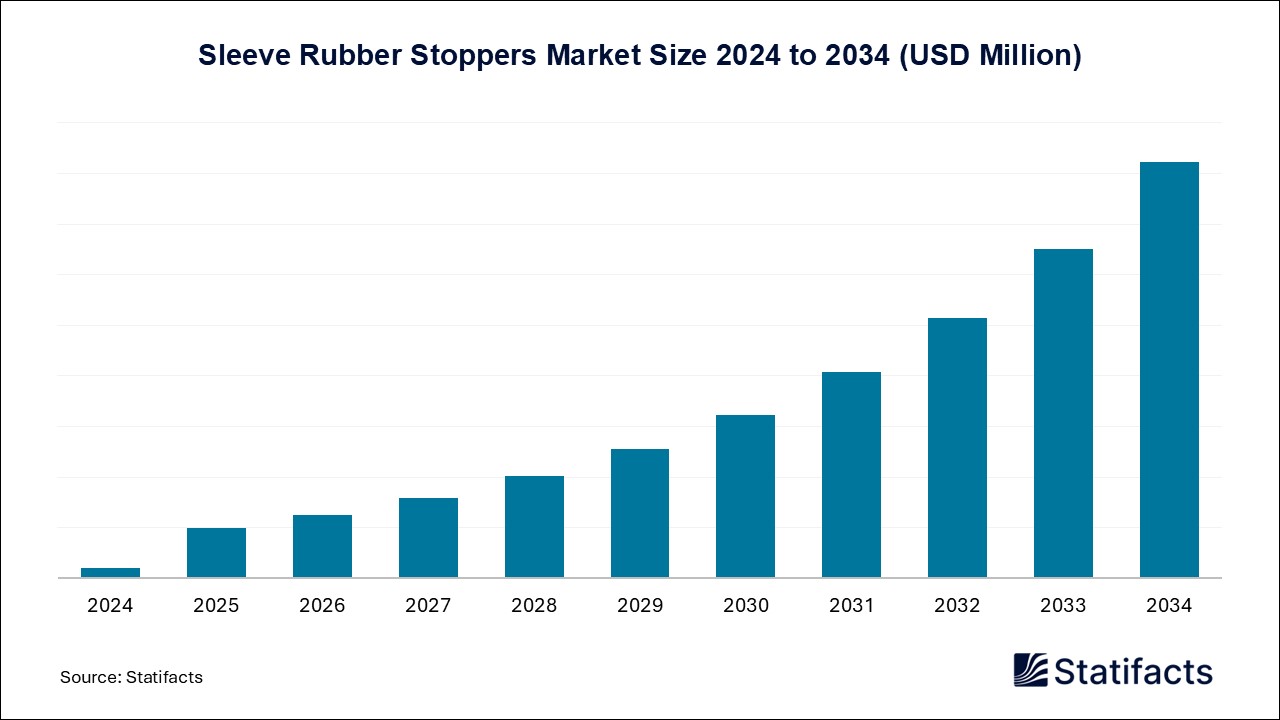Last Updated: 29 Jul 2025
Source: Statifacts
By clicking “Accept All Cookies” you agree to the storing of cookies on your device to enhance site navigation, analyze site usage, and assist in our marketing efforts.
Privacy PolicyThe US power distribution market size was calculated at USD 400.50 million in 2024 and is predicted to attain around USD 1,109.73 million by 2034, expanding at a CAGR of 10.72% from 2025 to 2034. Grid modernization is being driven by rising electricity demand from population growth, urbanization, and surging industrial commercial use. Integration of renewable energy calls for improved distribution capabilities and smart grid tech. Federal policy, including the Inflation Reduction Act and federal tax incentives, is supporting investments in digitization and resilience. Utilities are expanding infrastructure to accommodate distributed generation and energy storage.
| Reports Attributes | Statistics |
| Market Size in 2024 | USD 400.50 Million |
| Market Size in 2025 | USD 440.89 Million |
| Market Size in 2030 | USD 736.86 Million |
| Market Size by 2034 | USD 1109.73 Million |
| CAGR 2025 to 2034 | 10.72% |
| Base Year | 2024 |
| Forecast Period | 2025 to 2034 |
The U.S. power distribution market deals with smart grids and microgrids, which are advanced power distribution technologies transforming the U.S. energy infrastructure. Smart grid integrates digital communications, sensors, and analytics to match electricity supply and demand in real time, collecting over 500 TB of data annually for a typical 1 million customer utility to improve efficiency, reliability, and renewable integration. Microgrids, defined by the DOE as controllable entities that can operate independently from or alongside the main grid, serve critical facilities, campuses, communities, and remote areas. As of now, they contribute under 0.3% of U.S. electricity capacity, yet their capacity has surged nearly 11% in four years. These systems underpin sectors such as utilities, military bases, universities, hospitals, data centres, and rural communities.
AI is transforming U.S. power distribution by significantly accelerating the process of connecting new power supplies to the grid. In early 2025, Google partnered with PJM Interconnection, North America’s largest grid operator, to deploy AI tools that automate and streamline interconnection application reviews, reducing historically long wait times. These delays had ballooned to roughly 40 months for clean energy projects. Since implementing AI-driven automation, companies such as PJM have processed about 140 GW of connection requests and aim to reduce approval timelines to 1-2 years by 2026. This digital transformation supports faster integration of wind, solar, and natural gas capacity. Strengthening grid resilience amid rising electricity demand.
Drivers in the U.S. power distribution market are surging data center demand, driven by AI and cloud growth, is straining U.S. power infrastructure, prompting accelerated grid upgrades and streamlined federal policies to enable faster, more resilient energy deployment.
U.S. power distribution infrastructure is under intense pressure due to the explosive growth of data centres, particularly those supporting AI and cloud services. Data centre electricity consumption is projected to rise from 4.4% to between 6.7%-12% of national power use by 2028, significantly straining existing transmission and distribution systems, line upgrades, advanced forecasting tools, and modular control technologies to manage peak loads and avoid congestion. This demand surge is reshaping long-term planning, prompting utilities to deploy sophisticated solutions faster than ever before.
Federal and state governments are actively implementing policy reforms to expedite grid upgrades. FERC issued a rule requiring long-term transmission planning by RTOs, while both Biden and the Trump administrations are streamlining permitting to support AI-driven and renewable infrastructure. In parallel, federal directives such as those promoting a national AI Action Plan are targeting energy permitting under frameworks like the Clean Water Act to hasten new power projects. These regulatory moves are reducing bureaucratic barriers, enabling faster interconnections, and encouraging both traditional and clean energy investments.
Obstacles in the U.S. power distribution market are a surge in clean energy project applications and a shortage of critical grid infrastructure, like transformers, which are causing severe delays in U.S. interconnections, threatening cost efficiency and decarbonization goals.
Grid operators are grappling with a backlog of clean-energy and storage projects, causing significant delays in new connections. In 2023, power capacity in U.S. interconnection queues surged by 27% to 2,600 GW, with solar and storage making up 81% of applications. These delays inflate project costs and risk undermining decarbonisation efforts by 2035.
The U.S. suffers from a severe shortage of critical grid infrastructure. Lead times for key transforms have more than doubled since 2021, reaching up to 120 weeks. Over 80% of large power transformers are imported, exposing utilities to supply chain fragility and delaying vital upgrades.
Key growth avenues in the U.S. power distribution market include AI-driven grid innovations like Dynamic Line Ratings and domestic transformer production are enhancing U.S. grid resilience and efficiency, supporting a $2 trillion modernization push through 2050.
Innovative solutions such as Dynamic Line Ratings and AI-based transformer failure prediction are being adopted to optimize existing infrastructure. These technologies can boost transmission capacity by ~30% without requiring new lines, offering utilities a cost-effective alternative in a time-critical transition.
Siemens Energy will start producing large industrial transformers in North Carolina by 2027, reducing reliance on imports and improving grid resilience. This investment dovetails with an anticipated $2 trillion in U.S. grid upgrades through 2050.
“On-grid sales are increasingly attractive to us and to our customers,” said Dominguez as the company pivoted toward connecting AI-heavy data centres directly to the grid. This strategic shift comes amid growing concerns about reliability and cost in off-grid configurations.
"With the complexities of today's energy industry and the regulations that define it, an adaptable electric grid with access to both local and regional resources is essential for managing customer costs and maintaining service reliability.”
The smart grid segment underwent notable growth in the U.S. power distribution market during 2024. Smart-grid technologies remain the backbone of U.S. power distribution, largely because of advanced data-driven tools and regulatory support. Federal acts like EISA 2007 and stimulus funding from ARRA 2009 have cemented smart meters and two-way communication as grid essentials. Utilities such as ComEd have installed over 3 million smart meters, avoiding 7.6 million outages and saving $1.4 billion. These systems facilitate demand response, outage detection, integration of renewables, and AI-enabled load forecasting. As a result, the software and meter analytics component of the smart grid holds the largest market share and shapes distribution sector modernization.
Electric vehicle load growth is emerging as the rapidly expanding frontier in power distribution. U.S. EV adoption is projected to add between 100 and 185 TWh to annual demand by 2030, roughly 2.5-4.6% of total electricity use. To address this, utilities are deploying dynamic EV charging strategies, vehicle-to-grid capabilities, and flexible rate structures, transforming the EV integration segment is set to grow faster than any other, recasting the power distribution landscape through new hardware, software, and system planning paradigms.
The microgrid segment is gaining momentum thanks to its ability to provide local resilience and reliability. For example, Blue Lake Rancheria’s solar plus storage microgrid powered critical services during a 2022 earthquake and is expanding to 20 MW capacity. Over 1,100 U.S. microgrids now operate across hospitals, campuses, and communities, with solar accounting for over 50% of new deployments in 2023. This surge is driven by falling costs: solar panels down 90% and batteries 80% over the last decade. As regulators and utilities prioritize climate resilience, microgrids stand out for their decentralized control, faster implementation, and disaster readiness.
The U.S. power distribution market is best described as an oligopolistic structure dominated by several large, integrated utilities and infrastructure providers, but also presents room for specialized and tech-driven entrants due to rising demand and grid modernization pressures.
Quanta is a leading specialty contractor providing services across electric power, natural gas, and telecom infrastructure. Operating in North America, it offers transmission and distribution line construction, substations, and renewable energy systems. Quanta has been pivotal in servicing AI/data centre-driven grid upgrades and saw its stock surge ~870%. Over five years, driven by electric power (47% of Q1 revenues) and renewable energy (33%).
Siemens Energy manufacturers major grid components transformers, gas turbines, and switchgear, and is expanding domestic transformer production, with a Charlotte plant planned by 2027. U.S. Research and development focuses on power electronic grid solutions and decarbonisation technologies, aligning with a projected $2 trillion U.S. grid upgrade need by 2050.
CenterPoint delivers electricity, natural integrated energy services across the southern U.S It recently ramped up its grid capital plan by $500 million to address mounting demand from data centres anticipating a 50% local demand jump by 2031. Its product suite
Published by Shubham Desale
| Application | 2024 | 2025 | 2026 | 2027 | 2028 | 2029 | 2030 | 2031 | 2032 | 2033 | 2034 |
|---|---|---|---|---|---|---|---|---|---|---|---|
| Smart Grid | 260.15 | 286.51 | 319.19 | 353.03 | 391.23 | 435.40 | 479.27 | 528.74 | 587.86 | 654.34 | 722.58 |
| Microgrid | 140.35 | 156.92 | 171.78 | 190.57 | 210.65 | 231 | 258.56 | 288.19 | 316.65 | 347.13 | 386.25 |
Last Updated: 29 Jul 2025
Source: Statifacts
| Subsegment | 2024 | 2025 | 2026 | 2027 | 2028 | 2029 | 2030 | 2031 | 2032 | 2033 | 2034 |
|---|---|---|---|---|---|---|---|---|---|---|---|
| Smart Grid | 260.15 | 286.51 | 319.19 | 353.03 | 391.23 | 435.40 | 479.27 | 528.74 | 587.86 | 654.34 | 722.58 |
| Microgrid | 140.35 | 156.92 | 171.78 | 190.57 | 210.65 | 231 | 258.56 | 288.19 | 316.65 | 347.13 | 386.25 |
Electricity use is expanding due to growth in data centers, electric vehicles, urbanization, and industry. Grid modernization efforts and public policies further accelerate infrastructure upgrades.
Distribution lines and transformers are a key focus, especially intelligent medium-voltage networks. Utilities are replacing aging assets to improve resilience and handle new load demands.
Advanced grid technologies, like smart sensors, predictive maintenance, and digital switchgear, are enhancing reliability and integrating renewable sources. AI and IoT play a central role.
Federal programs such as the Infrastructure Investment and Jobs Act and DOE grants are boosting grid upgrades. FERC reforms and legislative proposals like the BIG WIRES Act aim to streamline transmission planning.
Utilities encounter high capital costs, permitting delays, supply chain constraints, and aging infrastructure. Grid security and capacity shortfalls under rising demand are also key concerns.
To get full access to our Market Insights, you need a Professional Account or a Business Suite.

You will receive an email from our Business Development Manager. Please be sure to check your SPAM/JUNK folder too.

You will receive an email from our Business Development Manager. Please be sure to check your SPAM/JUNK folder too.

Our customers work more efficiently and benefit from


